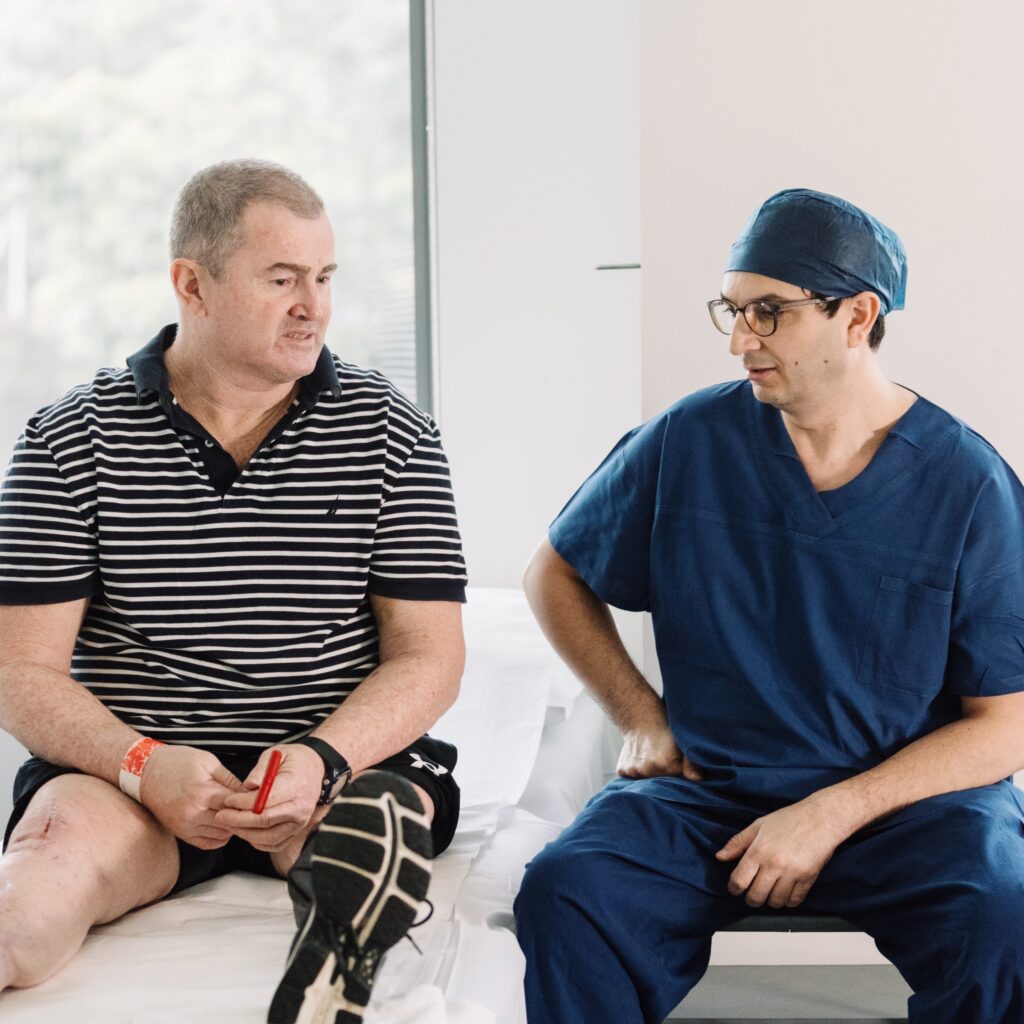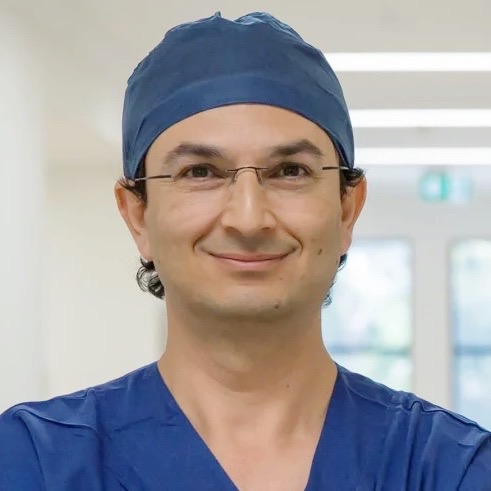
World class facilities, world class surgeons.
For 15 years, Osseointegration Group Clinics, hosted by the world-leading Limb Reconstruction Centre at Macquarie University Hospital, have worked to deliver a superior care experience for hundreds of people, from all walks of life, living with amputation.
As the world’s largest and most experienced osseointegration hub, Osseointegration Group enjoys a global reputation for care quality, from both patients and providers alike.

Driven by Prof. Dr Munjed Al Muderis, Osseointegration Group sits at the heart of a network of scientists, engineers, clinicians and innovators collectively redefining what’s possible with osseointegration, and delivering lifechanging results for our patients.
Our commitment to technical and technological innovation has attracted some of the best and brightest orthopaedic surgeons working in the field today. Often copied, but never bettered, our work has been shared in some of medicine’s most prestigious high-impact journals and presented to audiences at some of its most important events.
We understand that the surgical process can seem daunting. That’s why we work hard to ensure that you feel safe and supported every step of the way.
Our multidisciplinary team offers care, advice and expertise at every stage of your journey, from your initial enquiry, through your pre-surgical preparations to post-operative care and rehabilitation.
Our dedicated Clinical Management Team offers a ready source of advice and support from the outset, ensuring that you have the information necessary to make the right decisions for your care, while consultation, remote or in-person depending on your preference, provides a chance to meet your surgeon and ask any further questions you may have.
Following your surgery, our friendly, highly-trained rehabilitation specialists will deliver a tailored treatment plan that will help you reach your strength and mobility goals as quickly as possible, while optimising your comfort and wellbeing.

World-leading professionals committed to your wellbeing and the very highest standards of care excellence.

Orthopaedic Surgeon
Orthopaedic surgeon, limb reconstruction and osseointegration specialist.
A technical and technological pioneer in the field of osseointegration, he is the designer of the Osseointegrated Prosthetic Leg (OPL) implant and is responsible for the development of the single-stage OGAAP-2 surgical protocol, which makes the surgery safer and allows those undergoing osseointegration to return to normal life much more rapidly than was previously possible.

Once you’ve taken the decision to undergo your treatment with Osseointegration Group, what can you expect?
Pre-surgical assessment helps us to identify your specific needs and tailor our care to meet them.
It gives you the opportunity to meet with our physiotherapy, psychology, surgical and pain management specialists, and allows them the opportunity to fully assess your current health status.
It also allows us to recognise any additional actions that may be necessary before, or during, your care and identify and mitigate any risks that might be associated with your treatment plan.
Alongside your pre-surgical assessment, the OG Team will examine your historical and current imaging, size and build your implant, optimise your soft tissue management plan (including any nerve work or neuroma removal), and plan your surgery using specialist surgical software.
Notwithstanding complex cases, which can require multiple additional surgical steps, the osseointegration procedure can normally be completed in around 2-4 hours. The procedure itself can be performed using an epidural and/or other nerve blocks where required, although it is typically carried out under general anaesthetic.
It involves the preparation of your bone and the insertion of your intramedullary implant. The surgical team will modify your soft tissue to give you the best functional and cosmetic outcome, as well as preparing a hole through which the end of the implant can connect to your prosthesis, known as a stoma.
You will stay at the hospital as an in-patient for several days so that staff can closely monitor your immediate post-operative recovery.
Once you are able to mobilise, and any pain is well-controlled, you will be discharged and begin your rehabilitation as an outpatient.
Your osseointegration rehabilitation is a three-step process which may be completed according to a ‘fast-loading’ or ‘slow-loading’ protocol depending on your individual health factors.
Rehabilitation will involve learning how to complete basic moves, including standing, as well as gait training and exercise. You’ll also start to load your implant with weight, aiming eventually for a force equivalent to 50kg or 50% of your bodyweight.
Each subsequent stage of rehabilitation aims to increase your walking proficiency (including using stairs or moving across uneven ground), strengthen your muscles and secure your body’s connection to the implant.
Most osseointegration patients will be able to walk unaided around 4 months after surgery. However, with ongoing work, you will be able to further improve your gait and balance over time.
Many of our patients have previously been fitted with socket prosthetics. Existing prosthetics can be adapted to ensure their compatibility with your osseointegrated implant. Patients may also exchange their prosthetics, or parts thereof, or undergo fitting for new components for us in special circumstances (e.g., sports, swimming).
It is important to optimise the condition and alignment of your prosthetic as you work to regain your mobility.
Patients sometimes wish to complete their rehabilitation at home. Where this is the case, we will work with clinicians and rehabilitation specialists in your own country to ensure that they are able to deliver on your specific rehabilitation goals.
We will continue to monitor your recovery and complete regular remote follow-up consultations to ensure that we can adapt to any changes.
Once home, you will also be required to visit your local prosthetist for regular hardware assessment and component replacement, as necessary.
Yes! Professor Dr Munjed Al Muderis is the most experienced osseointegration surgeon in the OG. While he may be joined in your surgery by other members of the surgical team, he will normally complete the procedure himself.
The cost of osseointegration varies from person to person, and is calculated based on a wide range of particular health factors. Any cost will also take account of additional procedures that may need to be completed in advance of, or alongside your osseointegration, or the need for specialist hardware.
If you would like to discuss the cost of your surgery, please contact our team.
While osseointegration is available through Australia’s public health system, Macquarie University Hospital is a private institute, which means that the cost of surgery here is not covered.
Osseointegration is covered by a larger number of private health insurance plans, as well as by accident compensation and workers’ compensation. Patients can contact us for advice and guidance on their coverage.
Yes, you can. However, because we understand that additional costs can occasionally arise during treatment, it is our recommendation that you make arrangements for coverage, as far as is possible, through your insurance provider.
Our new NO-GAP (No Out-of-Pocket Expenses) payment scheme has been designed to help eligible patients avoid out-of-pocket costs from admission to post-operative rehabilitation, making high-quality healthcare more affordable to as many Australians as possible.
If you are travelling from overseas for your medical treatment, then you will need to apply for a visa before you travel to gain entry to Australia.
Our Clinical Management Team will be able to offer advice and guidance on the application process.
If you are travelling from overseas for your medical treatment, when you arrive in Australia, you will be collected at the airport and transferred to your accommodation.
Once you’ve settled in, we’ll begin your pre-surgical assessments. We advise that you arrive at least 3 days before your scheduled surgery date to allow sufficient time to complete all necessary assessments.
There is no set waiting list for osseointegration and it is often possible to accommodate urgent cases very quickly.
However, pre-surgical assessments, surgical planning and implant preparation carry an additional time requirement, which can be further extended for complex cases. If you are keen to complete your surgery urgently, please contact a member of our team.
Although you may choose to remain in Australia until you have healed completely, many of our patients elect to return home to complete their rehabilitation. In this case, we provide regular follow-ups with your surgeon, physiotherapist and prosthetist, either in-person for local patients or online for remote or international patients.
We also liaise with your local care provider to ensure that you can receive the highest level of post-operative care.
Please complete the enquiry form at the link below and a member of our Team will get in touch.
Macquarie University Clinic, Suite 303, Level 3/2 • NSW 2109, Australia.

The Osseointegration Group exists to enable amputees worldwide to improve their quality of life through the application of clincal expertise and technical and technological innovation.
The OPL Device is not approved for sale in the US. Please contact us for further information on device availability in your region. Information provided via this website is for educational and communication purposes only. The material presented represents techniques and procedures used by The Osseointegration Group (OG). OG disclaims any and all liability for injury and/or other damages which result from an individual using techniques presented on this website.